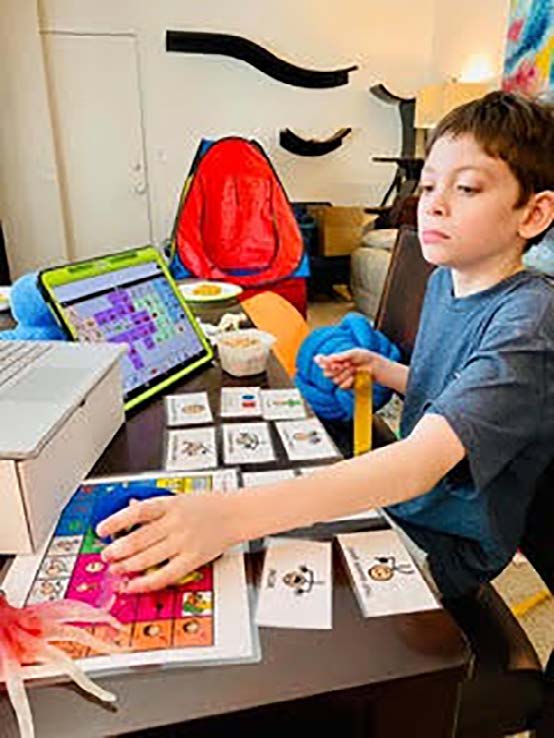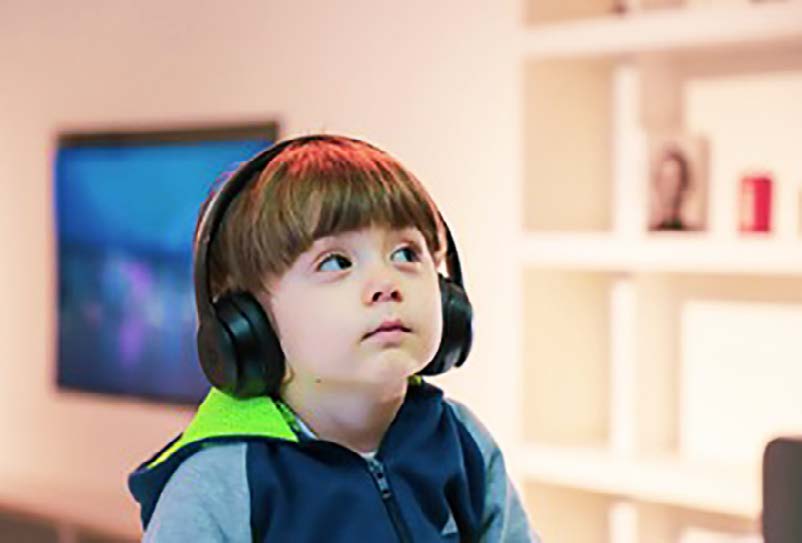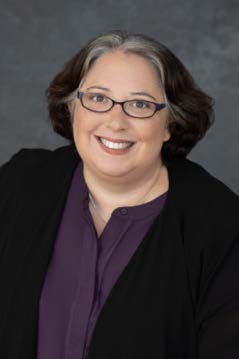Through catastrophe, there is great freedom and through freedom, discovery. Without this critical discovery, we remain stuck in our patterns, and this leaves us (and our children) without success.
REDEFINING CATASTROPHE
LESSONS FROM THE 'NEW NORMAL'
BY JENNIFER BOGIN, MSED, BCBA, LBA
"I thought the world had ended and we were screwed," Sarah Weirich, single mother of nine-year-old Tristan was just as freaked out as the rest of us on March 13th, 2020, when she got a message saying her son Tristan, who has severe (level 3) autism spectrum disorder (ASD), didn't have school for a week due to the COVID-19 outbreak in Massachusetts. A week turned into two and before she knew it, Tristan didn't have any in-person services for five months and counting.
Before the pandemic, Tristan was in a public school special education program for children with autism with a fulltime 1:1 Paraprofessional. At home, Tristan had private speech therapy and in-home Applied Behavior Analysis (ABA) services up to 20 hours per week. Sarah and Tristan's home resembled a revolving door of therapists, Behavior Analysts, and Behavior Technicians all week long.
As any parent or caregiver of a child on the autism spectrum will tell you, transitions are hard. According to the Autism Society, one of the nation's top non-profits dedicated to improving the lives of all affected by autism: "Transitions are often difficult for people on the autism spectrum and their families. People with ASD usually rely on routines to navigate social situations, and a sudden schedule or lifestyle change, such as beginning school, graduating, or starting a new job, can be very disruptive and discomforting." In light of this, the extreme disruptions that result from a global pandemic unlike any in the past century could be catastrophic for Tristan and Sarah and other families like them. However, with a lot of ingenuity, a strong support team, and a passion for meeting her child's needs, Sarah was able to do it. As Sarah, herself states: "It actually turned out better than anticipated, a lot better." Initially out of necessity, Sarah redefined the pandemic. She saw opportunity where others only saw catastrophe. To be clear, Sarah is unique but not uncommon. Every day I am impressed by the dedication and strength that parents of children with autism exhibit. They are truly warriors in the best sense of the word. It is simultaneously true that many, many parents struggle to meet the needs of their children regardless of diagnosis, ability level and developmental needs. Sometimes the best we can do is get out of bed in the morning and put one foot in front of the other. This story is not meant to shame or blame. We all do the best we can and many people need assistance that never comes.
In her podcast, On Being, Krista Tippett cites her friend, the Rev. Jen Bailey as saying "the original Greek, apocalypse doesn't mean the catastrophe; it means the uncovering. And this crisis, this virus, is uncovering a lot of things. It's uncovering kindness and generosity. It's uncovering things that we didn't know we knew how to do..." Perhaps ABA and other types of therapy for children with autism are uncovered skills. Perhaps, with the right support and training, parents and caregivers can provide their children all the therapy, support, and teaching they need.
First authorized in 1986, the Program for Infants and Toddlers with Disabilities (Part C of IDEA) is a federal grant program that assists states in operating a comprehensive, statewide program of early intervention services for infants and toddlers with disabilities. The law also mandated that these comprehensive services be provided in "natural environments" which are is defined as "settings that are natural or typical for a same-aged infant or toddler with out a disability." For many, that meant services were held in home environments with the parents or caregivers as the primary target of services. While not mandated by the government, parents and caregivers have been educating their children with special needs and developmental disabilities in their homes for years. Somehow the advent of in-home ABA pulled parents out of the spotlight and suddenly it was considered 'alright' or even 'preferable' that the parents didn't participate in the sessions.
Over the years, this issue has been brought to my attention when numerous parents (including Sarah Weirich) have complained to me that even well-meaning ABA providers say things such as: "they said I [the mother] was the problem" "I was dis tracting to my kid's learning" "shouldn't apply the techniques because I'm not trained in ABA" and many more. So, is it any wonder that we leave our parents/caregivers frustrated? Isolated? Lacking the skills they desperately need? On the other side of the coin, children with ASD become more rigid, stuck, and dependent on all the adults and therapists coming in and out of their lives. And we wonder why transitions are hard for them?



STAYING CONNECTED: (Above) Tristan participates in a Assistive and Augmentative Communication. Session. (Right) Noise cancelling headphones can be an effective incentive in the integration of newly developed therapies.
In their 2008 publication, "EvidenceBased Comprehensive Treatments for Early Autism," Rogers and Vismara discuss the inception of intensive Applied Behavior Analysis (ABA) services in homes and schools.
"In 1987 and 1993, Lovaas and colleagues published articles describing the "recovery" of almost 50% of a group of very young children with autism, treated intensively with applied behavioral analysis for several years (Lovaas, 1987; McEachin, Smith, & Lovaas, 1993). These articles suggested an entirely new way of thinking about autism: as a disorder marked by considerable plasticity, for which there was the hope of recovery given appropriate intervention. The effect these articles have had on thousands of parents who hoped to achieve a similar recovery for their children are less frequently acknowledged but no less important. Many parents have spent large amounts of their own money purchasing the services that they see as essential to their child's success. Intensive in-home Applied Behavior Analysis (ABA) services were further validated when, in July 2007, the Report and Plan on Services to Military Dependent Children with Autism in the Department of Defense were published and Tricare began covering in-home ABA services. Other insurance companies would follow suit to where we are today, with all but two states requiring private health insurance to cover medically necessary autism services in the home.
Enter the pandemic. When Coronavirus (Covid-19) struck, it created a rupture in the day-to-day lives and educations of children and families everywhere. For kids with autism, the Sarah dug deep and Tristan didn't regress, he progressed coneffect of this rupture was catastrophic. Suddenly, children who were receiving upwards of 40 hours per week of ABA therapy outside of school were getting nothing. A few ABA agencies were able to provide some remote services. Other families were left to choose between their child's health and safety and continuing in-home services. I know of two families where they had to abruptly end services due to the Behavior Tech testing positive for Covid-19. In one case, a BCBA was hospitalized with the virus after visiting three homes that week. With schools being suddenly closed, parents had to worry about childcare, behavior challenges, and the disappearance of the team of clinicians, therapists, and technicians that they had become accustomed to. How were parents and caregivers going to survive without childcare? Respite? PCA services? And, most important, how were we going to provide education?
Sarah dug deep and Tristan didn't regress, he progressed considerably over the months of quarantine. One resource Sarah credits is the Assistive and Augmentative Communication (AAC) Summer Camp Tristan attended. With high-quality instructors and dynamic curriculum and programing, Tristan participated in two half-hour long sessions per day. Typically, one was synchronous (live) and one asynchronous or pre-recorded. The sessions were effective in that they taught Sarah what she needed to know to program and personalize the AAC device for Tristan. Tristan and other children on the autism spectrum thrived with the structure and support the camp provided. While the actual in-person contact was limited, the parents were directly taught and supported in learning how their child learns.
Meanwhile, another group of Other families were left to choose between their child's health and safety and continuing in-home services. children on the spectrum were engaging in the Fields Center's Social Connection Virtual Group. Initially, the group was created for 1st and 2nd Grade children who were verbal communicators. Eventually, the group was so successful that the model was replicated for teens and then adults on the spectrum. The Social Connections group met twice a week for half-an-hour. The groups followed a similar routine every session: there is a greeting, topic, questions, and then departure. The topics ranged from simple social concepts (eye contact, body language, listening, sharing, etc.) to more complex subject matter (having autism, what are hurt feelings, the difference between thoughts and feelings.) The response was overwhelmingly positive.
REFRAMING A CATASTROPHE : COVID-19-SPECIFIC AUTISM RESOURCES
AUTISM SOCIETY Webinars, Covid resource tool-kit, access to "autism source" database, social stories on Covid related topics autism-society.org
NATIONAL AUTISM ASSOCIATION AUTISM SPEAKS Links to resources, webinars, facts about Covid-19 nationalautismassociation.org/covid-19-resources-for-families
AUTISM RESEARCH INSTITUTE Links to resources, personal story webinars, social stories and priming videos autism.org/covid-19-resources
SPECTRUM NEWS SPECIAL REPORT Facts and statistics, resources for families spectrumnews.org/features/special-reports/autism-and-the-coronavirus-pandemic
AUTISM SPEAKS Covid information for families, adults on the spectrum, educators and health professionals, event calendar, non-English resources autismspeaks.org/covid-19-information-and-resources
AUTISTIC SELF ADVOCACY NETWORK Links to teaching tools, social stories, tips for caregivers autisticadvocacy.org/covid19
When asked why she thought the group was so helpful for her daughter Ivy, one mother replied; "I didn't know how to talk to my child about some of these topics, but listening to you explain things so concretely while using visuals I finally understood how she thinks. I was able to bring the lessons home and that's where I saw the best progress." Before the COVID-19 pandemic, virtual groups were rarely used with young and elementary-aged children. Our minds opened by necessity, which created an opening for new ideas, new implications, and new techniques for working with children on the spectrum. The parents of the participants in the Social Connections group commented often at how helpful it was for their child's learning and growth over the months of quarantine, they talked about the learning and growth that never happened with the typical, somewhat rigid social skills curriculum that is most often taught to children on the spectrum.
The final example of new 'catastrophic thinking' consisted of behav ioral support for a 13-year-old boy with severe autism, explosive behavior, and minimal verbal skills. Edward was a large young man who tended to intimidate his parents and caregivers by yelling in their faces and sometimes grabbing at them. He also has self-injurious behaviors such as biting his thumb to the point of permanently damaging the skin. Edward had an AAC device but his behaviors were so severe and distracting that it kept him from fully understanding the fundamentals and using the device functionally. Edward's mother felt strongly that he should learn to wear a mask. He had health issues and needed to see doctors and specialists in the community. She knew that if Edward was ever going back to school, he would need a mask to stay healthy and safe. After a brief assessment, clinicians from the Fields Center's Family Navigation Program were able to identify three things that were strong reinforcers for Edward. He loved: skittles, videos on his iPad, and his noise-canceling headphones.
The BCBA decided to design and create a mask that could be group commented on how helpful it was for their child's learning and growth over the months of quarantine. attached to the noise-canceling headphones and therefore pair the negative (mask) with the positive (headphones.) Initially, it was difficult for Edward's mother to keep him from ripping the mask off, eventually, he was able to leave the headphones/mask on for a few seconds and then gradually increasing the time. By thinking 'outside the box' about wearing a mask paired with a preferred object, the BCBA was able to successfully design an intervention that the mother could implement with no in-person support. The BCBA had weekly zoom sessions with Edward's mother to continue to support the efforts. This too was integral for the success of the program.
The above vignettes illustrate how we can reframe catastrophe in light of the Covid-19 Pandemic. Taking the literal Greek meaning, the catastrophe, or uncovering, allows us to shed preconceived notions and break free from patterns of the past. From Tristan's AAC Camp, Ivy's Social Connections group, and Edward's behavior plan, all three of these children found enormous benefits in the virtual or remote services that they received. Without COVID-19, these methods would undoubtedly remain 'covered' by our ingrained thoughts about the way we are supposed to teach and learn. Through catastrophe, there is great freedom and through freedom, discovery. Without this critical discovery, we remain stuck in our patterns, and this leaves us (and our children) without success. So when we can, let's embrace the chaos, the messiness, and the catastrophe because without it we may never uncover our children's full potential.•
CLOSE TO HOME : RESOURCES CITED IN THIS ARTICLE
FIELDS CENTER FOR POSITIVE BEHAVIOR SUPPORT Jennifer Bogin's online resource for service providers and parents/caregivers of children with autism. Also find out more about the Family Navigation Program and the Social Connections Virtual Groups fieldscenter.org
EMBRACING THE SPECTRUM Sarah Weirich's self-proclaimed: Autism Mom, Autism Advocate, Sensory Architect and Savvy Spender Website. embracingthespectrum.org
COMMUNICARE, LLC Tristan's AAC provider and summer camp program aaccommunicare.com
ABOUT THE AUTHOR:

Jennifer Bogin is the Founder/Executive Director of the Fields Center for Positive Behavior Support. Fields Center provides training and resources to those who support individuals on the autism spectrum. With a passion for interdisciplinary services and Evidence-Based Practices, Jennifer has worked in various capacities with individuals with ASD from infancy to geriatrics. Most important, Jennifer is the aunt and sister to her nephew, brother and sister-in-law on the autism spectrum. Find out more at: fieldscenter.org
References
References Tippet, Krista. 2020, April 28. Living the Questions: How can we balance connection with disconnection? (Audio podcast) Sally J. Rogers, Laurie A. Vismara, J Clin Child Adolescent Psychol. Author manuscript; available in PMC 2010 Sep 22.Published in final edited form as: J Clin Child Adolescent Psychol. 2008 Jan; 37(1): 8– 38. doi: 10.1080/15374410701817808 Ellen G. Casale, J. Alacia Stainbrook, John E. Staubitz, Amy S. Weitlauf, A. Pablo Juárez, Chapter Six – The Promise of Telepractice to Address Functional and Behavioral Needs of Persons With Autism Spectrum Disorder, Editor(s): Robert M. Hodapp, Deborah J. Fidler, International Review of Research in Developmental Disabilities, Academic Press, Volume 53, 2017, Sharon Hinton, Jeanie Sheffield, Matthew R. Sanders, Kate Sofronoff, A randomdxized controlled trial of a telehealth parenting intervention: A mixed-disability trial, Research in Developmental Disabilities, Volume 65, 2017, Pages 74-85, Jac den Houting. Autism in Adulthood.Jun 2020.103-105. doi.org/10.1089/aut.2020.29012.jdh